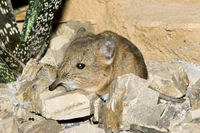Elephant shrew
2007 Schools Wikipedia Selection. Related subjects: Mammals
| iElephant shrews | ||||||||||
|---|---|---|---|---|---|---|---|---|---|---|
 Short-eared Elephant Shrew
(Macroscelides proboscideus) |
||||||||||
| Scientific classification | ||||||||||
|
||||||||||
|
|
||||||||||
|
Rhynchocyon |
The small insectivorous mammals native to Africa known as elephant shrews or jumping shrews belong to the Macroscelididae family, in the order Macroscelidea. Their traditional common English name comes from a fancied resemblance between their long noses and the trunk of an elephant, and an assumed relationship with the true shrews (family Soricidae) in the order Insectivora. As it has become plain that the elephant shrews are unrelated to the shrews, some people prefer to call them sengis, a term derived from the Bantu languages of Africa.
The 15 species vary in size from about 100 mm to almost 300 mm, from just under 50 g to over 500 g. All are quadrupedal with rather long legs for their size, and although the size of the trunk varies from one species to another, all are able to twist it about in search of food. Their diet is largely insects and other small creatures, particularly beetles, spiders, worms, ants, and termites, mostly gleaned from leaf litter, but they also take seeds and some green shoots. The Rhynchocyon species also dig small conical holes in the soil, bandicoot style.
They are widely distributed across the southern part of Africa, and although common nowhere, can be found in almost any type of habitat, from the Namib Desert to boulder-strewn outcrops in South Africa to thick forest. One species, the North African Elephant Shrew, remains in the semi-arid, mountainous country in the far north-west of the continent.
Although mostly diurnal and very active, they are difficult to trap and very seldom seen: sengis are wary, well camouflaged, and adept at dashing away from threats. Several species make a series of cleared pathways through the undergrowth and spend their day patrolling them for insect life: if disturbed, the pathway provides an obstacle-free escape route.
The evolutionary history of the sengis has long been obscure. At various stages, they have been classified with the shrews and hedgehogs as part of the Insectivora; regarded as distant relatives of the ungulates; grouped with the treeshrews; and lumped in with the hares and rabbits in Lagomorpha. Recent molecular evidence, however, weakly supports a superorder Afrotheria which unites tenrecs, and golden moles with certain ungulates or mammals that have been presumed to be ungulates, including hyraxes, sirenians, aardvarks and elephants.
However this arrangement is not supported by good anatomical evidence and although the relationship of the golden moles to tenrecs is quite likely and the relationship between hyraxes, sirenians and elephants is also well accepted, anatomically these two groups of mammals are different from one another and evidence suggests that the odd-toed ungulates are related to the African ungulates. Although the dentition of elephant shrews suggests that they might be ungulates their overall morphology has similaritites to the gnawing mammals.
- ORDER MACROSCELIDEA
- Family Macroscelididae
- Genus Elephantulus
- Short-snouted Elephant Shrew, Elephantulus brachyrhynchus
- Cape Elephant Shrew, Elephantulus edwardii
- Dusky-footed Elephant Shrew, Elephantulus fuscipes
- Dusky Elephant Shrew, Elephantulus fuscus
- Bushveld Elephant Shrew, Elephantulus intufi
- Eastern Rock Elephant Shrew, Elephantulus myurus
- Somali Elephant Shrew, Elephantulus revoili, endangered (EN)
- North African Elephant Shrew, Elephantulus rozeti
- Rufous Elephant Shrew, Elephantulus rufescens
- Western Rock Elephant Shrew, Elephantulus rupestris
- Genus Macroscelides
- Short-eared Elephant Shrew, Macroscelides proboscideus
- Genus Petrodromus
- Four-toed Elephant Shrew, Petrodromus tetradactylus
- Genus Rhynchocyon
- Golden-rumped Elephant Shrew, Rhynchocyon chrysopygus, endangered (EN)
- Checkered Elephant Shrew, Rhynchocyon cirnei, vulnerable (VU)
- Black and Rufous Elephant Shrew, Rhynchocyon petersi, endangered (EN)
- Genus Elephantulus
- Family Macroscelididae